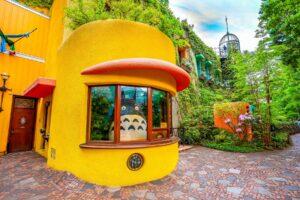Fodor's Expert Review Ueno Tosho-gu Shrine
This shrine, built in 1627, is dedicated to Ieyasu, the first Tokugawa shogun. It miraculously survived all major disasters that destroyed most of Tokyo's historical structures—the fires, the 1868 revolt, the 1923 earthquake, the 1945 bombings—making it one of the few early-Edo-period buildings left in Tokyo. The shrine and most of its art are designated National Treasures.
Two hundred ishidoro (stone lanterns) line the path from the stone entry arch to the shrine itself. One of them, just outside the arch to the left, and more than 18 feet high, is called obaketoro (ghost lantern). Legend has it that one night a samurai on guard duty slashed at a ghost (obake) that was believed to haunt the lantern. His sword was so strong, it left a nick in the stone, which can be seen today.
The first room inside the shrine is the Hall of Worship; the four paintings in gold on wooden panels are by Tan'yu, a member of the famous Kano family of artists, dating... READ MORE
This shrine, built in 1627, is dedicated to Ieyasu, the first Tokugawa shogun. It miraculously survived all major disasters that destroyed most of Tokyo's historical structures—the fires, the 1868 revolt, the 1923 earthquake, the 1945 bombings—making it one of the few early-Edo-period buildings left in Tokyo. The shrine and most of its art are designated National Treasures.
Two hundred ishidoro (stone lanterns) line the path from the stone entry arch to the shrine itself. One of them, just outside the arch to the left, and more than 18 feet high, is called obaketoro (ghost lantern). Legend has it that one night a samurai on guard duty slashed at a ghost (obake) that was believed to haunt the lantern. His sword was so strong, it left a nick in the stone, which can be seen today.
The first room inside the shrine is the Hall of Worship; the four paintings in gold on wooden panels are by Tan'yu, a member of the famous Kano family of artists, dating from the 15th century. Behind the Hall of Worship, connected by a passage called the haiden, is the sanctuary, where the spirit of Ieyasu is said to be enshrined.
The real glory of Tosho-gu is its so-called Chinese Gate, at the end of the building, and the fence on either side that has intricate carvings of birds, animals, fish, and shells of every description. The two long panels of the gate, with their dragons carved in relief, are attributed to Hidari Jingoro, a brilliant sculptor of the early Edo period whose real name is unknown (hidari means "left"; Jingoro was reportedly left-handed).
READ LESS








